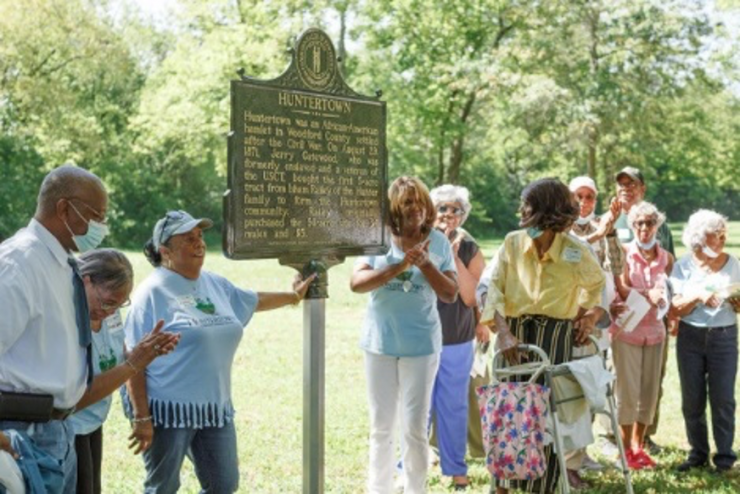Authored by Jayoung Koo, Daniel Vivian, Ryan Hargrove, Christopher Sass, Chad Eby, Sioux Finney, Lori Garkovich, Faye T. Kuosman, and T. Adam Probst.
Landscapes dedicated to significant persons of color and historical events consistently attract interest. However, precedents of landscapes interpreting the history and culture of the everyday lives of people of color are scarce and not widely publicized. Additionally, converting “everyday places” into “commemorative places” for communities of color does not attract much public interest, and the land is often purchased to be redeveloped by entities beyond the community.
The Sustainability Challenge Grant (SCG) Project entitled, Re-Visioning Huntertown: From African American Freetown to Interpretive Public Place, expands cultural planning and design implementation of Huntertown, the site of a former community of color transitioning into an educational public greenspace in Versailles-Woodford County.
Huntertown was an African American freetown settled in 1871 by formerly enslaved people in Woodford County. This thriving, close-knit community existed for nearly 140 years. Due to environmental concerns, properties were purchased by the county government through a Community Development Block Grant. Residents were relocated, and the site was cleared of vacant homes between 2003 and 2010.

The Huntertown Community Interpretive Park Committee, the Versailles-Woodford County Parks and Recreation Department, and the Woodford County Fiscal Court envisioned preserving Huntertown’s history and story by designing and building an interpretive, yet passive, green space on the 38-acre site adjacent to the Bluegrass Parkway. The creation of Huntertown Community Interpretive Park (HCIP) is an extraordinary opportunity to interpret the historical, cultural, environmental, and spatial character of a post-Civil War African American freetown. From the summer of 2020 through the summer of 2021, the UK Department of Landscape Architecture facilitated the Phase 1 planning and design of the HCIP, which was adopted by the Woodford County Park and Recreation Board. Previous efforts provided foundational steps that aided in developing the Phase 1 park design and provided critical cultural and historical data for interpretation. However, we have also learned that there needs to be more research on the historical, cultural, and bio-physical aspects of the Huntertown site that were not fully understood previously.
Starting in the summer of 2021, the newly awarded SCG grant Re-Visioning Huntertown continues efforts to recognize and communicate the history of a post-Civil War African American “freetown” as a public place with a Phase 2 planning strategy. This phase includes further historical research, design and implementation of interpretive wayfinding, and feasibility studies of stormwater infrastructure. The community partnered project is contributing to the UK community’s efforts to overcome challenges for sustainability through a multi-disciplinary approach. UK students are learning and engaging with the Versailles-Woodford County community, while the project team is developing a model for future similar projects.
The HCIP project is providing a unique glimpse into the sociocultural heritage of Woodford County and engages a new generation of citizens in learning about the shared history of the Huntertown landscape. Descendants of former Huntertown residents celebrated the 150th anniversary of the establishment of Huntertown this past summer and have plans to continue reunions on-site.

Environmentally, the site displays diverse habitats and environmental rehabilitation needs, which are adding aesthetic and educational interest for future users. The park also has the potential to increase connectivity in the community for physical activity and well-being while educating about past and present environmental degradation and rehabilitation. The HCIP has become a new community public space at the southeastern edge of the county where planned public green space is absent.
Our current multi-disciplinary team is seeking missing information, collecting further on-site data for environmental considerations, designing and creating wayfinding and interpretive installations embedding the historic information of the Huntertown community through digital media platforms, and generating ideas for a longer-term park design. The Phase 2 plan is supporting a public space design and partial implementation of the park’s construction in order to support the HCIP committee’s effort to continue the community’s interest and momentum to tell their story into the future and avoid the erasure of the site’s unique history. Furthermore, the history of Huntertown offers an opportunity to spark deep discussions with students about diversity, equity, and inclusion. Research on the history of Huntertown and other “freetowns” in Central Kentucky will highlight the transition from slavery to freedom and the conditions African Americans faced during the late nineteenth and early twentieth centuries. Exploring these subjects and developing sample interpretive displays will illuminate racial inequalities across generations; highlight relationships between social, political, and environmental inequality; and underscore the roots of contemporary racial divides.
Ultimately, the project aims to 1) help users and audiences better understand diversity, equity, and inclusion considerations for transitioning landscapes as well as their past occupants and present and future users, 2) advance ecological sustainability, and 3) advance social equity by providing a sound public space where diverse users from varied backgrounds can feel welcomed and learn about the history and legacy of an African American freetown created in the immediate aftermath of the Civil War.
The knowledge to address, interpret, and represent the sustainability of the Huntertown Community Interpretive Park as a public space while creatively layering its important historical narrative through physical expressions is an important research, engagement, and teaching opportunity for not only the UK community but also the broader public.
The overall goal for the project is to continue the re-visioning of the HCIP based on preliminary work. The team is filling in the gaps of unanswered questions from previous efforts and is addressing the sustainability challenge of re-visioning the HCIP as an educational landscape for the broader region. The UK campus and HCIP site are simultaneously becoming learning laboratories for faculty and students that can be seen in the following objectives:
1) Cultural Landscape Planning and Design (Dr. Koo)
2) Preserving, Interpreting, and Communicating the History of Huntertown (Dr. Vivian)
3) Physical Design on Wayfinding Signage (Dr. Hargrove)
4) Stormwater Quantity and Quality (Dr. Sass, Ms. Kuosman, and Mr. Probst)
5) Communication of the Significance of the Landscape (Mr. Eby)
6) Community Outreach, Engagement, and Stewardship (Ms. Finney and Dr. Garkovich)

The Huntertown Interpretive Community Park will be more than a place to gather and engage in passive recreational activities. It will also contribute to the economic wealth of the community. There is mounting evidence that public parks and green space (particularly those interconnected with trails) can bring new economic value to communities and that parks and green space amenities have a positive impact on the economic growth of cities of all sizes.
The rebirth of Huntertown and its re-imagining as the HCIP also promises to spark discussions about diversity, equity, and inclusion in Woodford County. Hopefully, this project will provide a framework for similar efforts in other freetowns in Central Kentucky and throughout the Commonwealth. Furthermore, by showcasing the history of Huntertown and the legacy of African American freetowns in Central Kentucky, this project will highlight the historical roots of contemporary inequalities and stimulate needed conversations about addressing them


























